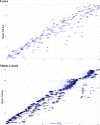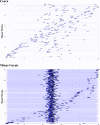Assessment of Area-Level Disease Control and Surveillance Vulnerabilities: An Application to Visceral Leishmaniasis in Brazil
- PMID: 31162014
- PMCID: PMC6609190
- DOI: 10.4269/ajtmh.18-0327
Assessment of Area-Level Disease Control and Surveillance Vulnerabilities: An Application to Visceral Leishmaniasis in Brazil
Abstract
The large number of activities contributing to zoonoses surveillance and control capability, on both human and animal domains, and their likely heterogeneous implementation across administrative units make assessment and comparisons of capability performance between such units a complex task. Such comparisons are important to identify gaps in capability development, which could lead to clusters of vulnerable areas, and to rank and subsequently prioritize resource allocation toward the least capable administrative units. Area-level preparedness is a multidimensional entity and, to the best of our knowledge, there is no consensus on a single comprehensive indicator, or combination of indicators, in a summary metric. We use Bayesian spatial factor analysis models to jointly estimate and rank disease control and surveillance capabilities against visceral leishmaniasis (VL) at the municipality level in Brazil. The latent level of joint capability is informed by four variables at each municipality, three reflecting efforts to monitor and control the disease in humans, and one variable informing surveillance capability on the reservoir, the domestic dog. Because of the large volume of missing data, we applied imputation techniques to allow production of comprehensive rankings. We were able to show the application of these models to this sparse dataset and present a ranked list of municipalities based on their overall VL capability. We discuss improvements to our models, and additional applications.
Figures




Comment in
-
Statistical Models for Infectious Diseases: A Useful Tool for Practical Decision-Making.Am J Trop Med Hyg. 2019 Jul;101(1):1-2. doi: 10.4269/ajtmh.19-0354. Am J Trop Med Hyg. 2019. PMID: 31134882 Free PMC article. No abstract available.
Similar articles
-
Spatial analysis for identification of priority areas for surveillance and control in a visceral leishmaniasis endemic area in Brazil.Acta Trop. 2014 Mar;131:56-62. doi: 10.1016/j.actatropica.2013.12.002. Epub 2013 Dec 14. Acta Trop. 2014. PMID: 24342506
-
Space-time analysis of the incidence of human visceral leishmaniasis (VL) and prevalence of canine VL in a municipality of southeastern Brazil: Identification of priority areas for surveillance and control.Acta Trop. 2019 Sep;197:105052. doi: 10.1016/j.actatropica.2019.105052. Epub 2019 Jun 22. Acta Trop. 2019. PMID: 31233726
-
Revisiting area risk classification of visceral leishmaniasis in Brazil.BMC Infect Dis. 2019 Jan 3;19(1):2. doi: 10.1186/s12879-018-3564-0. BMC Infect Dis. 2019. PMID: 30606104 Free PMC article.
-
Visceral leishmaniasis in Brazil: revisiting paradigms of epidemiology and control.Rev Inst Med Trop Sao Paulo. 2006 May-Jun;48(3):151-6. doi: 10.1590/s0036-46652006000300007. Epub 2006 Jul 5. Rev Inst Med Trop Sao Paulo. 2006. PMID: 16847505 Review.
-
Epidemiological aspects of the first human autochthonous visceral leishmaniosis cases in Porto Alegre, Brazil.Braz J Infect Dis. 2019 Mar-Apr;23(2):124-129. doi: 10.1016/j.bjid.2019.04.004. Epub 2019 May 21. Braz J Infect Dis. 2019. PMID: 31125529 Free PMC article. Review.
Cited by
-
Statistical Models for Infectious Diseases: A Useful Tool for Practical Decision-Making.Am J Trop Med Hyg. 2019 Jul;101(1):1-2. doi: 10.4269/ajtmh.19-0354. Am J Trop Med Hyg. 2019. PMID: 31134882 Free PMC article. No abstract available.
References
-
- Vinhaes MC, de Oliveira SV, Reis PO, de Lacerda Sousa AC, Silva RA, Obara MT, Bezerra CM, da Costa VM, Alves RV, Gurgel-Goncales R, 2014. Assessing the vulnerability of Brazilian municipalities to the vectorial transmission of Trypanosoma cruzi using multi-criteria-decision analysis. Acta Trop 137: 105–110. - PubMed
-
- Hogan JW, Tchernis R, 2004. Bayesian factor analysis for spatially correlated data, with application to summarizing area-level material deprivation from cesus data. J Am Stat Assoc 99: 314–324.
-
- WHO , 2005. International Health Regulations, 2nd edition Geneva, Switzerland: World Health Organization; Available at: http://www.who.int/topics/international_health_regulations/en/. Accessed March 1, 2018.
MeSH terms
Substances
LinkOut - more resources
Full Text Sources

